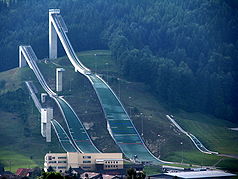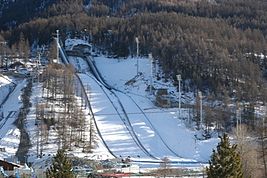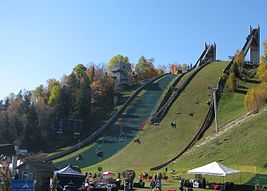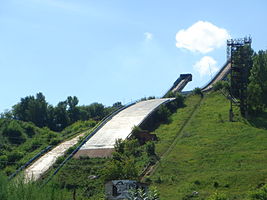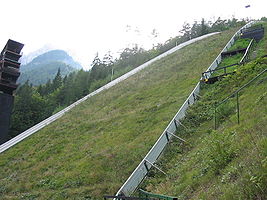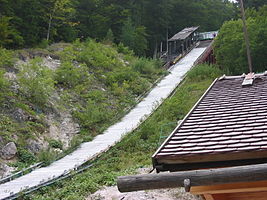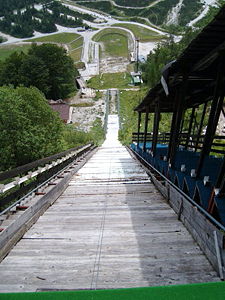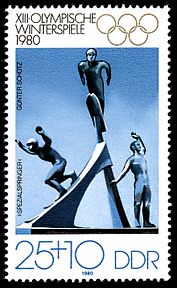- Ski jumping
-
"Ski jump" redirects here. For the element of an aircraft carrier's flight deck, see Flight Deck#Ski-jump ramp.
Ski jumping 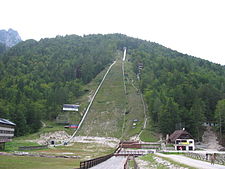
Letalnica Bratov Gorišek in Planica, SloveniaHighest governing body International Ski Federation First played 1808
Eidsberg, NorwayCharacteristics Team members Individual or groups Olympic 2010 Ski jumping facility in Einsiedeln, Switzerland
Ski jumping is a sport in which skiers go down a take-off ramp, jump and attempt to land as far as possible down the hill below. In addition to the length of the jump, judges give points for style. The skis used for ski jumping are wide and long (260 to 275 centimetres (100 to 108 in)). Ski jumping is predominantly a winter sport, performed on snow, and is part of the Winter Olympic Games, but can also be performed in summer on artificial surfaces – porcelain or frost rail track on the inrun, plastic on the landing hill.
Contents
History
True ski jumping originates in Morgedal, Norway. Olaf Rye, a Norwegian lieutenant, was the first known ski jumper. In 1809, he launched himself 9.5 metres in the air in front of an audience of other soldiers. By 1862, ski jumpers were tackling much larger jumps and traveling longer. Norway's Sondre Norheim jumped 30 metres over a rock without the benefit of poles. His record stood for three decades. The first proper competition was held in Trysil. The first widely known ski jumping competition was the Husebyrennene, held in Oslo in 1879, with Olaf Haugann of Norway setting the first world record for the longest ski jump at 20 metres.[1] The annual event was moved to Holmenkollen from 1892, and Holmenkollen has remained the pinnacle of ski jumping venues.
According to the International Olympic Committee's site[2]:
Ski jumping has been part of the Olympic Winter Games since the first Games in Chamonix Mont-Blanc in 1924. The Large Hill competition was included on the Olympic programme for the 1964 Olympic Games in Innsbruck.
Competition
Today, FIS Ski Jumping World Cup are held on three types of hills:
- Normal hill competitions
- for which the calculation line is found at approximately 80–100 metres (260–330 ft). Distances of up to and over 110 metres (360 ft) can be reached.
- Large hill competitions
- for which the calculation line is found at approximately 120–130 metres (390–430 ft). Distances of over 145 metres (476 ft) can be obtained on the larger hills. Both individual and team competitions are run on these hills.
- Ski-flying competitions
- for which the calculation line is found at 185 metres (607 ft). The Ski Flying World Record of 246.5 metres (809 ft) is held by Johan Remen Evensen, and was set in Vikersundbakken, Norway in February 2011.
Amateur and junior competitions are held on smaller hills.
Individual Olympic competition consists of a training jump and two scored jumps. The team event consists of four members of the same nation, who each jump twice.
Ski jumping is one of the two elements of the Nordic combined sport.
Summer jumping
Ski jumping can also be performed in the summer on a porcelain track and plastic grass combined with water. There are also many competitions during the summer. The World Cup (Summer Grand Prix) often includes those hills:
- Hinterzarten K-95
- Courchevel K-120
- Einsiedeln K-105
- Klingenthal K-125
- Zakopane K-120
- Hakuba K-120
- Pragelato K-125
- Liberec K-120
- Kranj K-100
- Wisla K-120
- Szczyrk K-90
- Hinzenbach K-85
- Almaty K-120
- Örnsköldsvik K-90
Ski jumping Fis-Cup and Continental Cup also have summer competitions and even more than the World Cup.
Women's ski jumping
On 26 May 2006, the International Ski Federation decided to allow women to ski jump at the 2009 Nordic World Ski Championships in Liberec, Czech Republic and then to have a team event for women at the 2011 world championships. FIS also decided to submit a proposal to the International Olympic Committee (IOC) to allow women to compete at the 2010 Winter Olympics in Vancouver.[3]
On 28 November 2006, the proposal for a women's ski jumping event was rejected by the Executive Board of the IOC. The reason for the rejection cited the low number of athletes as well as few participating countries in the sport. The Executive Board noted that women's ski jumping has yet to be fully established internationally.[4] Jacques Rogge, president of the International Olympic Committee stated that women's ski jumping will not be an Olympic event because "we do not want the medals to be diluted and watered down," referring to the relatively small number of potential competitors in women's ski jumping.[5]
It has been noted that while the number of women in ski jumping is not insignificant, the field has a much wider spread in terms of talent, in that the top men are all of a similar level of strength competitively, while the women are more varied, even in the top tiers.[6]
A group of 15 competitive female ski jumpers filed a suit against the Vancouver Organizing Committee (VANOC) claiming that conducting a men's ski jumping event without a women's event in the Vancouver Winter Olympics in 2010 would be in direct violation of Section 15 of the Canadian Charter of Rights and Freedoms.[7] The arguments associated with this suit were argued 20 to 24 April 2009 and a judgment came down on June 10, 2009 against the ski jumpers. The judge ruled that although the women were being discriminated against,[8] the issue is a International Olympic Committee responsibility and thus not governed by the charter. It further ruled that the Canadian Charter of Rights and Freedoms does not apply to VANOC.[9] Three British Columbia judges unanimously denied an appeal on November 13, 2009. The American actress and documentary film producer Virginia Madsen has chronicled the Canadian team's efforts in a film called Fighting Gravity (2009).[10]
On April 6, 2011 the International Olympic Committee officially accepted women ski jumping into the official Olympic program for the 2014 Winter Olympics in Sochi, Russia.[11]
Records
All Pre-World Cup, Olympic Games, World Championships & World Cup events are included. (As of 20 March 2011)
Category Ski Jumper Record Date/Year Olympic Games (1924-2010) most individual victories  Simon Ammann
Simon Ammann4 2002–2010 all medals  Matti Nykänen
Matti Nykänen5 1984–1988 most team victories  Finland Team
Finland Team2 1988–1992  Germany Team
Germany Team2 1994–2002  Austria Team
Austria Team2 2006–2010 most team medals  Austria Team
Austria Team5 1992–2010 youngest winner individual (Albertville)  Toni Nieminen
Toni Nieminen16 y, 261 d 1992 oldest winner individual (Lillehammer)  Jens Weißflog
Jens Weißflog29 y, 214 d 1994 by No. of Olympic appearances  Noriaki Kasai
Noriaki Kasai6 1992–2010 FIS Nordic World Ski Championships (1925-2011) most individual victories  Adam Małysz
Adam Małysz4 2001–2007 most individual medals  Adam Małysz
Adam Małysz6 2001–2011 all medals  Janne Ahonen
Janne Ahonen10 1995–2005  Martin Schmitt
Martin Schmitt10 1997–2011 most team victories  Austria Team
Austria Team8 1984–2011 most team medals  Austria Team
Austria Team14 1984–2011 youngest winner individual (Thunder Bay)  Tommy Ingebrigtsen
Tommy Ingebrigtsen17 y, 222 d 1995 oldest winner individual (Liberec)  Andreas Küttel
Andreas Küttel29 y, 308 d 2009 by No. of Championships appearances  Noriaki Kasai
Noriaki Kasai10 1989–2009 FIS Ski-Flying World Championships (1972-2010) most individual victories  Walter Steiner
Walter Steiner2 1972–1977  Sven Hannawald
Sven Hannawald2 2000–2002  Roar Ljøkelsøy
Roar Ljøkelsøy2 2004–2006 most individual medals  Matti Nykänen
Matti Nykänen5 1983–1990 all medals  Janne Ahonen
Janne Ahonen7 1996–2008 most team victories  Norway Team
Norway Team2 2004–2006  Austria Team
Austria Team2 2008–2010 most team medals  Norway Team
Norway Team4 2004–2010  Finland Team
Finland Team4 2004–2010 youngest winner individual (Oberstdorf)  Gregor Schlierenzauer
Gregor Schlierenzauer18 y, 47 d 2008 oldest winner individual (Bad Mitterndorf)  Roar Ljøkelsøy
Roar Ljøkelsøy29 y, 228 d 2006 by No. of Championships appearances  Janne Ahonen
Janne Ahonen9 1994–2010 Four Hills Tournament (1952-2011) most overall victories  Janne Ahonen
Janne Ahonen5 1999–2008 most individual victories  Jens Weißflog
Jens Weißflog10 1983–1996 youngest winner individual (Oberstdorf)  Toni Nieminen
Toni Nieminen16 y, 212 d 29 December 1991 oldest winner individual (Bischofshofen)  Jens Weißflog
Jens Weißflog31 y, 169 d 6 January 1996 youngest winner overall  Toni Nieminen
Toni Nieminen16 y, 220 d 1991–92 oldest winner overall  Jens Weißflog
Jens Weißflog31 y, 169 d 1995–96 World Cup (1979-2011) most overall wins  Matti Nykänen
Matti Nykänen4 1983–1988  Adam Małysz
Adam Małysz4 2001–2007 most individual victories  Matti Nykänen
Matti Nykänen46 1981–1989 most individual podiums  Janne Ahonen
Janne Ahonen108 1993–2010 most individual Top 10 results  Janne Ahonen
Janne Ahonen245 1993–2011 most team victories  Austria team
Austria team23 1990–2011 most team medals  Austria team
Austria team45 1990–2011 most individual performances  Noriaki Kasai
Noriaki Kasai396 1989-active most team performances  Noriaki Kasai
Noriaki Kasai39 1990-active all performances  Noriaki Kasai
Noriaki Kasai435 1989-active most seasons  Noriaki Kasai
Noriaki Kasai22 1989-active most ski-flying individual victories  Gregor Schlierenzauer
Gregor Schlierenzauer10 2006-active youngest winner individual (Lahti)  Steve Collins
Steve Collins15 y, 362 d 9 March 1980 oldest winner individual (Kuopio)  Takanobu Okabe
Takanobu Okabe38 y, 135 d 10 March 2009 youngest winner overall  Toni Nieminen
Toni Nieminen16 y, 303 d 1991-92 oldest winner overall  Adam Małysz
Adam Małysz29 y, 112 d 2006-07 most wins in one season individual  Gregor Schlierenzauer
Gregor Schlierenzauer13 2008-09 most points in one season individual  Gregor Schlierenzauer
Gregor Schlierenzauer2083 (points) 2008-09 Other records (all times) first jump over 100m (Planica)  Sepp Bradl
Sepp Bradl101m 1936 first jump over 200m (Planica)  Andreas Goldberger (fall, invalid)
Andreas Goldberger (fall, invalid)202m* 1994  Toni Nieminen (official)
Toni Nieminen (official)203m 1994 most jumps over 200m  Adam Małysz
Adam Małysz114 1995-2011 world record (Vikersund)  Johan Remen Evensen
Johan Remen Evensen246.5m 2011 first World Cup individual event  Cortina d'Ampezzo
Cortina d'AmpezzoDecember 1979 first World Cup team event  Lahti
LahtiMarch 1990 Scoring
The winner is decided on a scoring system based on distance, style, inrun length and wind conditions.
Each hill has a target called the calculation point (or K point or "critical point") which is a par distance to aim for. It is also the place where many jumpers land, in the middle of the landing area. This point is marked by the K line on the landing strip. For K-90 and K-120 competitions, the K line is at 90 metres (300 ft) and 120 metres (390 ft) respectively. Skiers are awarded 60 points if they land on the K Line. Skiers not landing on the K Line receive or lose points for every metre (3 ft) they miss the mark by, depending on if they surpass it or fall short, respectively. Thus, it is possible for a jumper to get a negative score if the jump is way short of the K line with poor style marks (typically a fall). The value of a metre is determined from the size of the hill. The K point is the point on the hill where the slope begins to flatten as measured from the take off.
In addition, five judges are based in a tower to the side of the expected landing point. They can award up to 20 points each for style based on keeping the skis steady during flight, balance, good body position, and landing. The highest and lowest style scores are disregarded, with the remaining three scores added to the distance score. Thus, a perfectly scored K-120 jump - with at least four of the judges awarding 20 points each - and the jumper landing on the K-point, is awarded a total of 120 points.
In January 2010, a new scoring system was introduced to compensate for variable outdoor conditions. Aerodynamics and take-off speed are important variables that determine the value of a jump, and if weather conditions change during a competition, the conditions will not be equal for everyone and thus unfair. The jumper will now receive or lose points if the inrun length is adjusted. An advanced calculation also determines plus/minus points for the actual wind conditions at the time of the jump. These points are added or withdrawn from the original scores from the jump itself.
In the individual event, the scores from each skier's two competition jumps are combined to determine the winner.
Rules
Ski jumpers below the minimum safe body mass index are penalized with a shorter maximum ski length, reducing the aerodynamic lift they can achieve. These rules have been credited with stopping the most severe cases of underweight athletes, but some competitors still lose weight to maximize the distance they can jump.[12]
Technique
The ski jump is divided into four separate sections; 1) In-run, 2) Take-off (jump), 3) Flight and 4) Landing. In each part the athlete is required to pay attention to and practice a particular technique in order to maximise the outcome of ultimate length and style marks.
Using the modern V-technique, pioneered by Jan Boklöv of Sweden in 1985, world-class skiers are able to exceed the distance of the take-off hill by about 10% compared to the previous technique with parallel skis. Aerodynamics has become a factor of increasing importance in modern ski jumping, with recent rules addressing the regulation of ski jumping suits. This follows a period when loopholes in the rules seemed to favour skinny jumpers in stiff, air foil-like suits.
Previous techniques first included the Kongsberger technique, developed in Kongsberg, Norway by two ski jumpers, Jacob Tullin Thams and Sigmund Ruud following World War I. This technique had the upper body bent at the hip, a wide forward lean, and arms extended to the front with the skis parallel to each other. It would lead to jumping length going from 45 meters to over 100 meters. In the 1950s Andreas Daescher of Switzerland and Erich Windisch of Germany modified the Kongsberger technique by placing his arms backward toward his hips for a closer lean. The Daescher technique and Windisch technique were the standard for ski jumping from the 1950s.
Until the mid 1970s, the Ski jumper would come down the in-run of the hill with both arms pointing forwards. This changed when the former East German Ski jumper Jochen Danneberg introduced the new in-run technique of directing the arms backwards in a more aerodynamic position.
The landing requires the skiers to touch the ground in the Telemark landing style. This involves the jumper landing with one foot in front of the other, mimicking the style of the Norwegian inventors of Telemark skiing. Failure to comply with this regulation will lead to the deduction of style marks (points).
Popularity
Ski jumping is popular among spectators and TV audiences in Scandinavia and Central Europe. Almost all world-class ski jumpers come from those regions or from Japan. Traditionally, the strongest countries are Finland, Norway, Germany, Austria, Poland, Switzerland, Slovenia, and Japan. However, there have always been successful ski jumpers from other countries as well (see list below). The Four Hills Tournament, held annually at four sites in Bavaria, Germany and Austria around New Year's, is very popular.
There have been attempts to spread the popularity of the sport by finding ways by which the construction and upkeep of practicing and competition venues can be made easier. These include plastic fake snow to provide a slippery surface even during the summer time and in locations where snow is a rare occurrence.
Ski flying
List of ski flying hills
Hill name Location Opened K-point Hill size Hill record  Vikersundbakken
VikersundbakkenVikersund, Norway 1936 K-195 HS 225 246.5 metres (809 ft)  Letalnica Bratov Gorišek
Letalnica Bratov GorišekPlanica, Slovenia 1969 K-185 HS 215 239.0 metres (784.1 ft)  Heini-Klopfer-Skiflugschanze
Heini-Klopfer-SkiflugschanzeOberstdorf, Germany 1950 K-185 HS 213 225.5 metres (740 ft)  Čerťák
ČerťákHarrachov, Czech Republic 1979 K-185 HS 205 215.5 metres (707 ft)  Kulm
KulmBad Mitterndorf, Austria 1950 K-185 HS 200 215.5 metres (707 ft)  Copper Peak
Copper PeakIronwood, Michigan, United States 1969 K-145 - 158.0 metres (518.4 ft) Ski flying is an extreme version of ski jumping. The events take place in big hills with a K-spot of at least 185 metres (607 ft). The difference between ski flying and "regular" ski jumping is subtle, but ski flying puts more focus on the ability to float through the air and less on pure jumping ability. Nonetheless, most of the top competitors in "regular" ski jumping tend to be among the best in ski flying competitions as well. However, some jumpers, such as Martin Koch of Austria, Johan Remen Evensen from Norway and Slovenia's Robert Kranjec are regarded as ski flying specialists.
The "father" of ski flying is Janez Gorišek, an engineer, sportsman and enthusiastic sport-promoter who designed the Planica ski-jump. There are five ski flying hills in the world today: Vikersundbakken in Vikersund, Norway; Oberstdorf, Germany; Kulm Austria; Letalnica, Planica, Slovenia; and Harrachov, Czech Republic. A sixth hill, Copper Peak in the western Upper Peninsula of Michigan, is currently disused, although there are plans to rebuild it to FIS standards.[13] There are plans for more ski flying hills, even for an indoor ski flying hill in Ylitornio, Finland. The biggest hill is Vikersundbakken in Vikersund.
It is possible to fly more than 200 metres (660 ft) in all the ski flying hills, and the current World Record is 246.5 metres (809 ft), set by Norwegian Johan Remen Evensen at Vikersund in 2011.
The Fédération Internationale de Ski (FIS) Ski flying World Championships started in 1972 and have been held on a mainly biennial basis, although there have been several occasions where events were held annually. The 2010 FIS World Championships in skiflying were organised in Planica, and in 2012 the FIS World Championships will take place in Vikersund, Norway.
Record number of official jumps over 200m
Rank Ski Jumper # 1.  Adam Małysz (POL)
Adam Małysz (POL)114 2.  Robert Kranjec (SLO)
Robert Kranjec (SLO)108 3.  Matti Hautamäki (FIN)
Matti Hautamäki (FIN)104 4.  Martin Koch (AUT)
Martin Koch (AUT)103 5.  Bjørn Einar Romøren (NOR)
Bjørn Einar Romøren (NOR)101 ...  Thomas Morgenstern (AUT)
Thomas Morgenstern (AUT)97 ...  Simon Ammann (SUI)
Simon Ammann (SUI)86 ...  Gregor Schlierenzauer (AUT)
Gregor Schlierenzauer (AUT)64 - As of 20 March 2011.
Notable ski jumpers
The most notable ski jumpers may be considered those who have managed to show a perfect jump, which means that all five judges attributed the maximum style score of 20 points for their jumps.
So far only 5 jumpers are recorded to have achieved this:
Name Date Location Competition Rank  Anton Innauer
Anton Innauer7 March 1976[14]  Oberstdorf
OberstdorfSki flying (International ski flying weeks) 1  Kazuyoshi Funaki
Kazuyoshi Funaki15 February 1998[15]  Nagano
NaganoOlympic Winter Games, large hill, second jump 1  Sven Hannawald
Sven Hannawald8 February 2003[16]  Willingen
WillingenWorldcup competition, large hill, first jump 1  Hideharu Miyahira
Hideharu Miyahira8 February 2003[16]  Willingen
WillingenWorldcup competition, large hill, second jump 6  Wolfgang Loitzl
Wolfgang Loitzl6 January 2009[17]  Bischofshofen
BischofshofenFour Hills Jumping, large hill, first jump 1 Sven Hannawald and Wolfgang Loitzl were attributed four times 20 (plus another 19,5) style score points for their second jump, thus receiving nine times the maximum score of 20 points within one competition.
Other notable ski jumpers can be found in the following lists:
- Winners of the FIS Ski Jumping World Cup
- Winners of Olympic Winter Games / Ski Jumping
- Winners of Nordic World Ski Championships / Ski Jumping
- Winners of the Four Hill Jumping
Male
Ski jumping facility in Nizhny Novgorod, Russia
Female
 Anette Sagen
Anette Sagen Eva Ganster
Eva Ganster Lindsey Van
Lindsey Van Jessica Jerome
Jessica Jerome Daniela Iraschko
Daniela Iraschko Elena Runggaldier
Elena Runggaldier Evelyn Insam
Evelyn Insam Lisa Demetz
Lisa Demetz Coline Mattel
Coline Mattel Anna Hafele
Anna Hafele Magdalena Schnurr
Magdalena Schnurr Ulrike Grässler
Ulrike Grässler Line Jahr
Line Jahr Jacqueline Seifriedsberger
Jacqueline Seifriedsberger Juliane Seyfarth
Juliane Seyfarth Eva Logar
Eva Logar Maja Vtič
Maja Vtič Anja Tepeš
Anja Tepeš Špela Rogelj
Špela Rogelj Manja Pograjc
Manja Pograjc
Unsuccessful
 /
/ Vinko Bogataj - Best known as "The Agony of Defeat man" because of the constant use of footage of his spectacular tumble in the title sequence of ABC's Wide World of Sports
Vinko Bogataj - Best known as "The Agony of Defeat man" because of the constant use of footage of his spectacular tumble in the title sequence of ABC's Wide World of Sports Eddie "The Eagle" Edwards - Popular favourite at the 1988 Winter Olympics
Eddie "The Eagle" Edwards - Popular favourite at the 1988 Winter Olympics
Important venues
- Ski jumping World Cup
 Engelberg, Switzerland
Engelberg, Switzerland Harrachov, Czech Republic
Harrachov, Czech Republic Kranj, Slovenia
Kranj, Slovenia Kulm, Austria
Kulm, Austria Kuusamo, Finland
Kuusamo, Finland Liberec, Czech Republic
Liberec, Czech Republic Planica, Slovenia
Planica, Slovenia Predazzo, Italy
Predazzo, Italy Sapporo, Japan
Sapporo, Japan Pragelato, Italy
Pragelato, Italy Trondheim (Granåsen), Norway
Trondheim (Granåsen), Norway Vikersund (Vikersundbakken), Norway
Vikersund (Vikersundbakken), Norway  Villach, Austria
Villach, Austria Willingen, Germany
Willingen, Germany Zakopane, Poland
Zakopane, Poland
- Four Hills Tournament
 Oberstdorf, Germany
Oberstdorf, Germany Garmisch-Partenkirchen, Germany
Garmisch-Partenkirchen, Germany Innsbruck (Bergisel), Austria
Innsbruck (Bergisel), Austria Bischofshofen, Austria
Bischofshofen, Austria
- Nordic Tournament
National records
Rank Nation Record holder Length Venue Year Skis 1.  Norway
NorwayJohan Remen Evensen 246.5 metres (809 ft) Vikersund 2011 Elan 2.  Austria
AustriaGregor Schlierenzauer 243.5 metres (799 ft) Vikersund 2011 Fischer 3.  Finland
FinlandJanne Happonen 240 metres (790 ft) Vikersund 2011 Fischer 4.  Switzerland
SwitzerlandSimon Ammann 238.5 metres (782 ft) Vikersund 2011 Fischer 5.  Czech Republic
Czech RepublicAntonin Hajek 236 metres (774 ft) Planica 2010 Fischer 6.  Slovenia
SloveniaRobert Kranjec 232 metres (761 ft) Vikersund 2011 Fischer 7.  Poland
PolandAdam Małysz 230.5 metres (756 ft) Vikersund 2011 Fischer 8.  Russia
RussiaDimitri Vassiliev 228 metres (748 ft) Planica 2005 Fischer 9.  Germany
GermanyMichael Neumayer 227.5 metres (746 ft) Planica 2005 Atomic 10.  Japan
JapanNoriaki Kasai 224 metres (735 ft) Planica 2010 Fischer 11.  United States
United StatesAlan Alborn 221.5 metres (727 ft) Planica 2002 Fischer 12.  France
FranceEmmanuel Chedal 215.5 metres (707 ft) Planica 2009 Fischer 13.  Italy
ItalyAndrea Morassi 215.5 metres (707 ft) Planica 2011 Elan 14.  Sweden
SwedenIsak Grimholm 207.5 metres (681 ft) Planica 2007 Elan 15.  Belarus
BelarusPetr Chaadaev 206.5 metres (677 ft) - - - 16.  Kazakhstan
KazakhstanRadik Zhaparov 196.5 metres (645 ft) Planica 2007 - 17.  Slovakia
SlovakiaMartin Mesik 195.5 metres (641 ft) Kulm 2006 - 18.  Estonia
EstoniaJens Salumäe 195 metres (640 ft) Planica 2004 - 19.  Canada
CanadaStefan Read 191.5 metres (628 ft) Planica 2007 Elan 20.  South Korea
South KoreaChoi Heung-Chul 191 metres (627 ft) - - Fischer 21.  Ukraine
UkraineVitaliy Shumbarets 189.5 metres (622 ft) Planica 2009 Elan 22.  Bulgaria
BulgariaPetar Fartunov 175 metres (574 ft) Planica 2009 - 23.  Netherlands
NetherlandsChristoph Kreuzer 162 metres (531 ft) - - - 24.  Hungary
HungaryGabor Geller 139 metres (456 ft) - - - 25.  Turkey
TurkeyBaris Demirci 123 metres (404 ft) - - - 26.  Kyrgyzstan
KyrgyzstanDmitry Chvykov 122 metres (400 ft) - - - 27.  Romania
RomaniaFlorin Spulber 118 metres (387 ft) - - - 28.  China
ChinaTian Zhandong 118 metres (387 ft) - - - 29.  United Kingdom
United KingdomGlynn Pedersen 113.5 metres (372 ft) - - - 30.  Georgia
GeorgiaKakhaber Tsakadze 105 metres (344 ft) - - - 31.  Moldova
MoldovaFilipciuc Ivan 95 metres (312 ft) - - - 32.  Wales
WalesMark Wayne Evans 85.5 metres (281 ft) - - - 33.  Argentina
ArgentinaFerdinand Gomez 78 metres (256 ft) - - - 34.  Armenia
ArmeniaSarahn Czizkabika 49.5 metres (162 ft) Gibswil 2011 - 35.  Montenegro
MontenegroBozo Cvorovic 46 metres (151 ft) Zabijak - - 35.  Tuvalu
TuvaluToaripi Tuilimu 11 metres (36 ft) Gibswil 2012 - Water ski jumping
See also: Water skiingThe ski jump is performed on two long skis similar to those a beginner uses, with a specialized tailfin that is somewhat shorter and much wider (so it will support the weight of the skier when he is on the jump ramp). Skiers towed behind a boat at fixed speed, maneuver to achieve the maximum speed when hitting a ramp floating in the water, launching themselves into the air with the goal of traveling as far as possible before touching the water. Professional ski jumpers can travel up to 70 metres (230 ft). The skier must successfully land and retain control of the ski rope to be awarded the distance.
An extreme version of this sport named Ski Flying was promoted by Scot Ellis and Jim Cara, in which boat speeds and ramp heights are boosted because physics have proved that the standard 75 feet (23 m) line and traditional 35 miles per hour (56 km/h) boat speed is outrun by the skier and the pro skier was ahead of the boat, being held back by the line.
See also
- Four Hills Tournament
- Freestyle skiing
- List of FIS Ski Jumping World Cup team medalists
- List of the longest ski jumps & World records
- Medicinernes Skiklub Svartor
- Ski jumping at the Winter Olympics
- Ski jumping World Cup
- Skiing and Skiing Topics
References
- ^ Oslo – Huseby (Ski Jumping Hill Archive)
- ^ "Ski Jumping". International Olympic Committee. http://www.olympic.org/en/content/Sports/All-Sports/Skiing/Ski-Jumping/.
- ^ "FIS MEDIA INFO: Decisions of the 45th International Ski Congress in Vilamoura/Algarve (POR)". Fédération Internationale de Ski. 2006-05-26. http://www.fis-ski.com/uk/news/pressreleases/pressreleases2006/gacongressdecisions.html. Retrieved 2009-11-14.
- ^ IOC approves skicross; rejects women's ski jumping
- ^ "Rogge: Women jumpers would dilute Olympics medals". CTV News. 2008-02-28. http://www.ctv.ca/servlet/ArticleNews/story/CTVNews/20080228/ski_jumping_080227/20080228/. Retrieved 2009-11-14.
- ^ Christa Case Bryant (2009-11-08). "Why women can't ski jump in the Winter Olympics". Christian Science Monitor. http://www.csmonitor.com/2009/1109/p17s03-ussc.html. Retrieved 2009-11-14.
- ^ Cindy Chan (2009-04-29). "Female Ski Jumpers Seem Olympic Inclusion". Epoch Times. http://www.theepochtimes.com/n2/content/view/16139/. Retrieved 2009-11-14.
- ^ Rod Mickelburgh (2009-07-10). "No female flight in 2010: B.C. court rejects ski jump bid". CTV Olympics. http://www.ctvolympics.ca/ski-jumping/news/newsid=12739.html#no+female+flight+2010?cid=rssctv. Retrieved 2009-11-14.
- ^ CBC News (2009-07-10). "Female ski jumpers lose Olympic battle". CBC News. http://www.cbc.ca/canada/british-columbia/story/2009/07/10/bc-olympic-women-ski-jump-decision.html. Retrieved 2009-11-14.
- ^ Tatianan Siegel, "Virginia Madsen to defy 'Gravity'", Variety, Apr. 8, 2009
- ^ Olympic.org
- ^ For Ski Jumpers, a Sliding Scale of Weight, Distance and Health
- ^ [1][dead link]
- ^ Vom Olymp zu den Fischen auf faz.net
- ^ Australian Olympic Committee commenting the Olympic Winter Games of Nagano 1998
- ^ a b FIS result list 8 February 2003, Rank 1 Hannawald, Rank 6 Miyahira (PDF-File, 379 kB)
- ^ FIS result list 6 January 2009, Rank 1 Loitzl (PDF-File, 273 kB)
External links
- skijumping.de - Biggest German website about ski jumping
- skijumpingcentral.com A great English language ski jumping resource
- Olympic Ski Jumping History
- World's longest ski jump Bjørn Einar Romøren video
- International Ski Federation Scoring, rules, measurement of jumps, etc. can be found here.
- Norge Ski Club / Training area The oldest ski jumping club in the United States.
Olympic sports Summer sports Archery • Athletics • Badminton • Basketball • Boxing • Canoeing • Cycling • Diving • Equestrian • Field hockey • Fencing • Football • Gymnastics • Handball • Judo • Modern pentathlon • Rowing • Sailing • Shooting • Swimming • Synchronized swimming • Table tennis • Taekwondo • Tennis • Triathlon • Volleyball • Water polo • Weightlifting • Greco-Roman Wrestling
Winter sports Alpine skiing • Biathlon • Bobsleigh • Cross-country skiing • Curling • Figure skating • Freestyle skiing • Ice hockey • Luge • Nordic combined • Short track speed skating • Skeleton • Ski jumping • Snowboarding • Speed skating
Former Olympic sports Baseball • Basque pelota • Cricket • Croquet • Golf • Jeu de paume • Lacrosse • Polo • Rackets • Roque • Rugby union • Softball • Tug of war • Water motorsports
Part of the 2016 program See also: Paralympic sportsCategories:- Individual sports
- Olympic sports
- Winter sports
- Ski jumping
Wikimedia Foundation. 2010.

